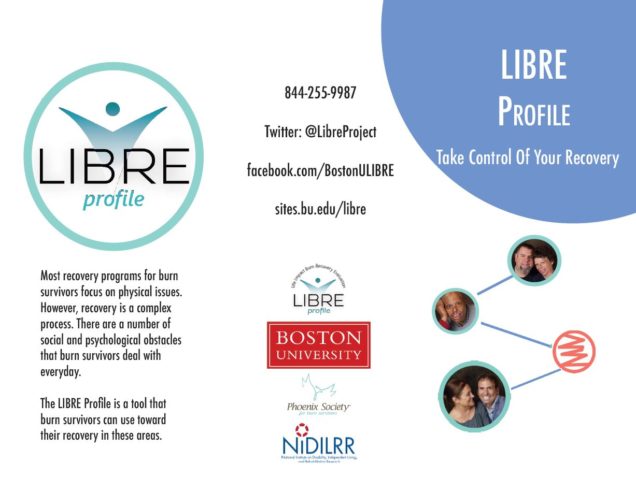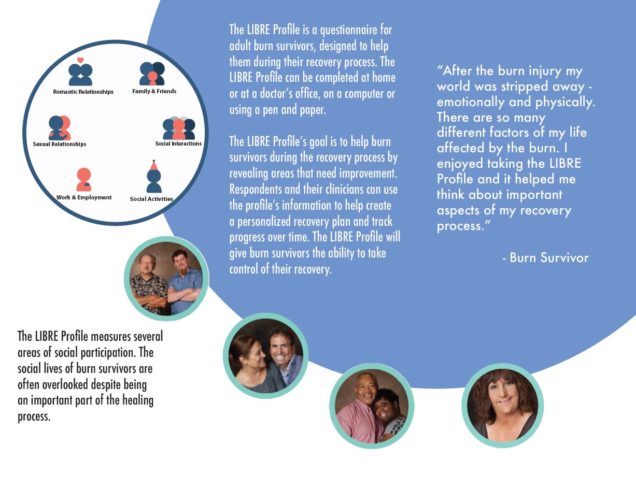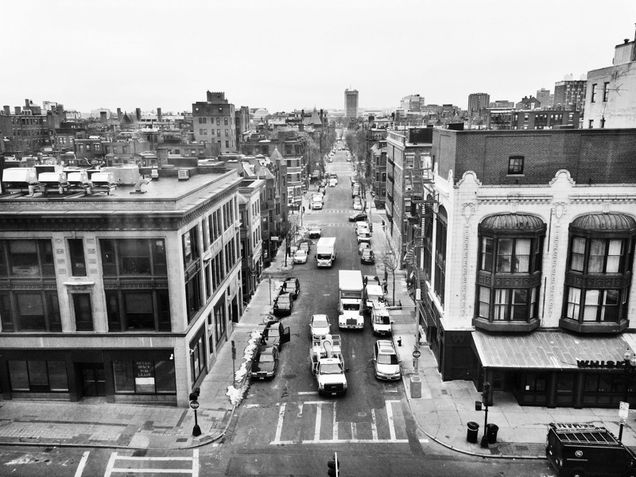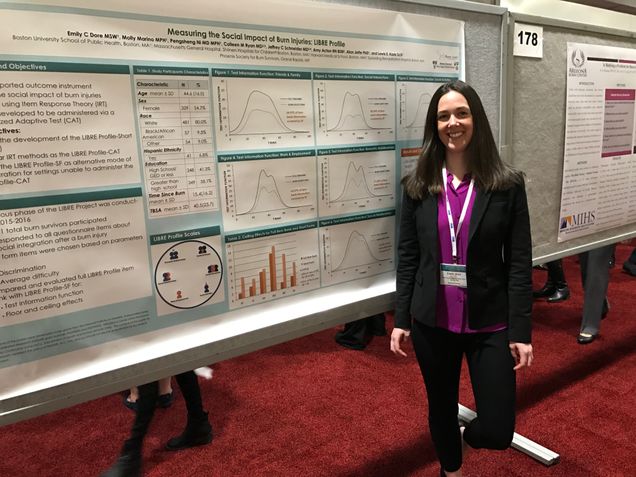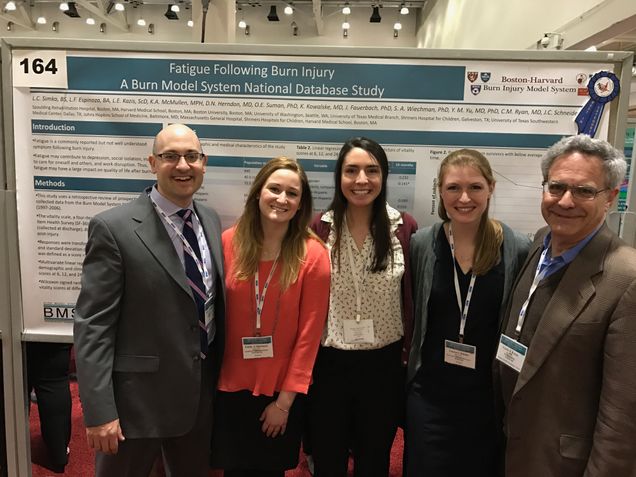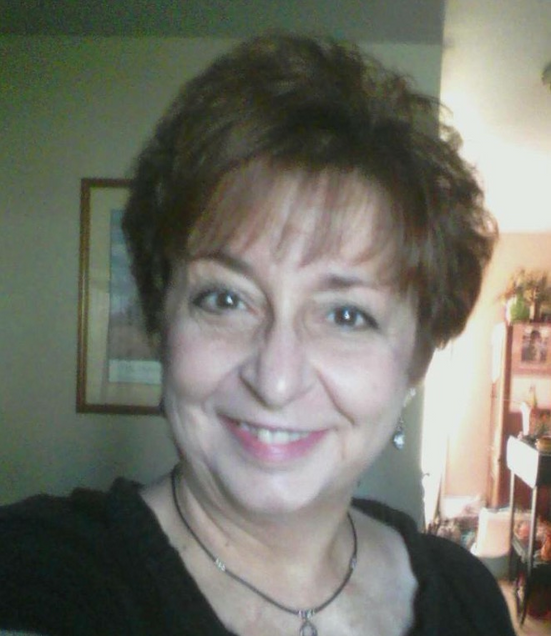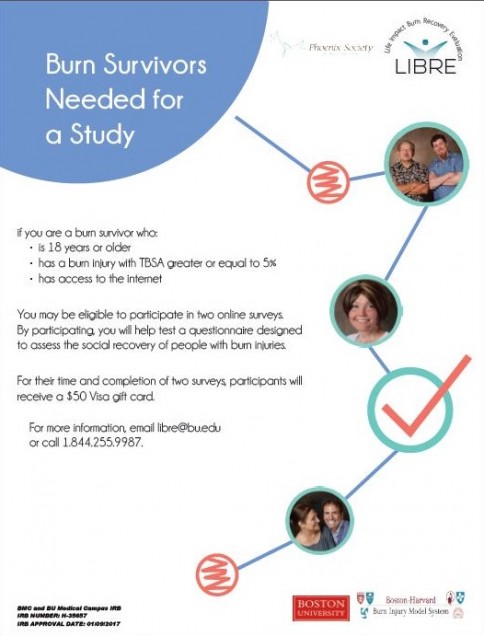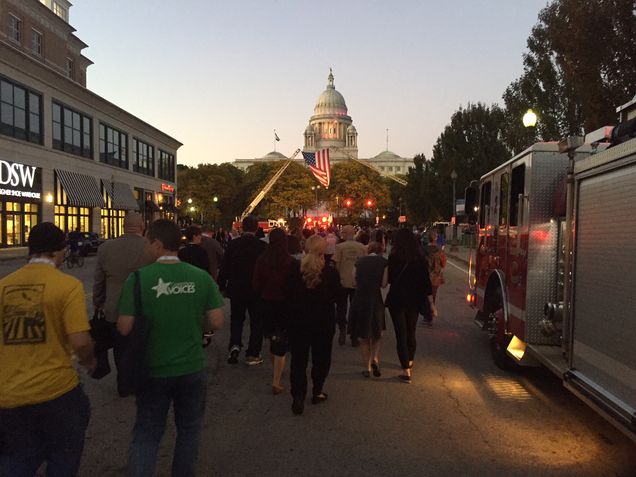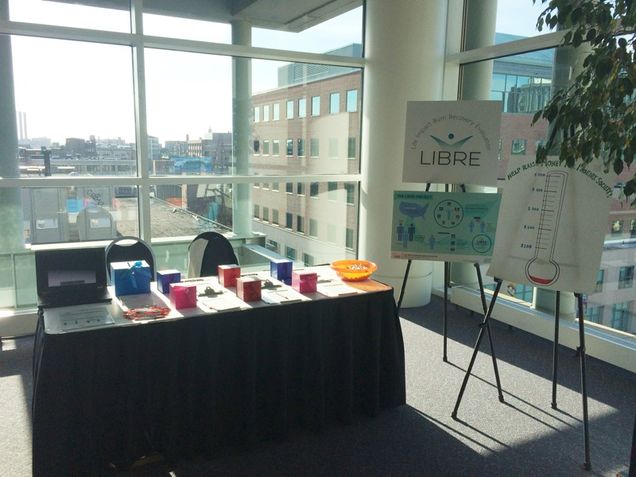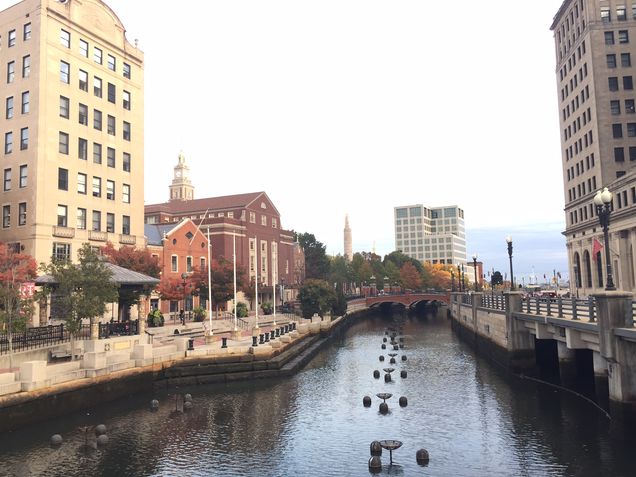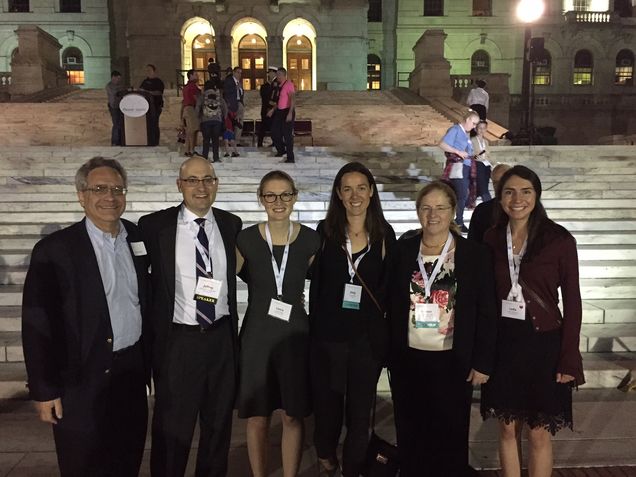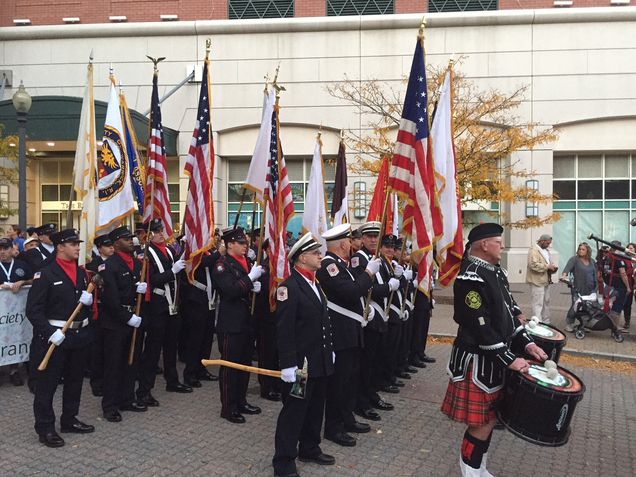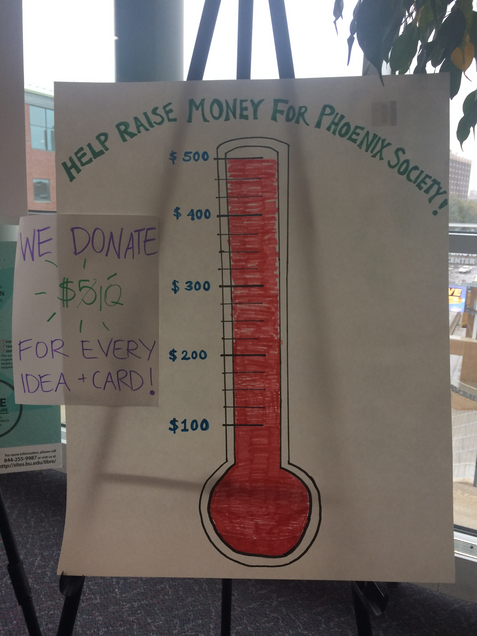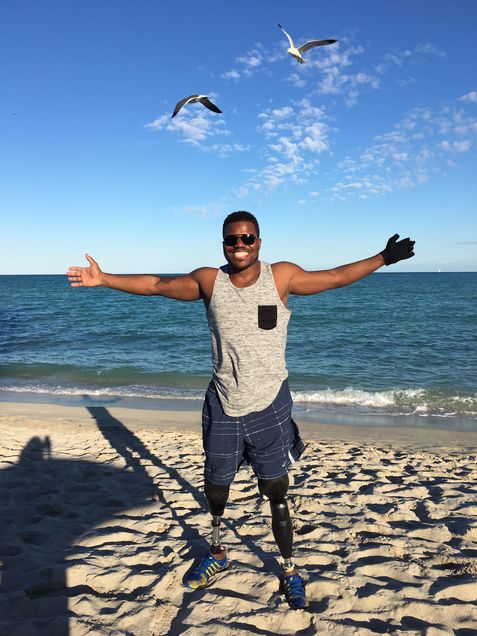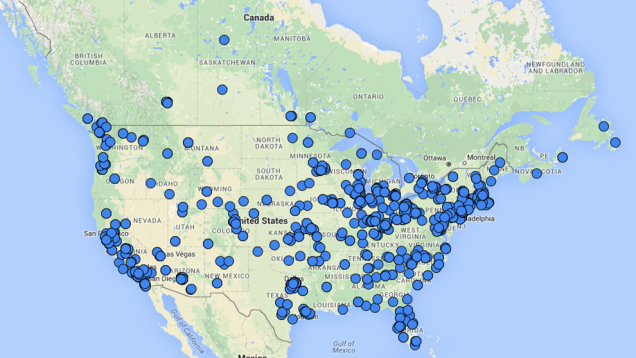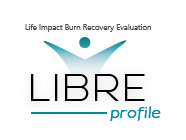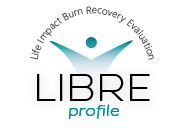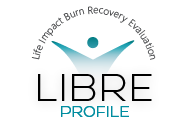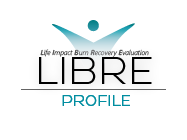Category: Uncategorized
LIBRE Profile: Perspectives from PWBC
This new video, filmed at Phoenix World Burn Congress 2017, highlights the impact of burn injury on social participation and speaks to the need for a tool such as the LIBRE Profile to measure social recovery. The burn survivors and burn community throughout the country have played a critical role in the development of the LIBRE Profile. That involvement does not stop now that we have the finished product. The feedback of burn survivors, clinicians, and researchers continues to be essential to guide the future use of the LIBRE Profile. A warm thank you to everyone who participated in the video, and a special shout out of gratitude to Amy Acton, Karen Colligan, Dennis Gardin, David Vogel, and Sadie Wilcox, for sharing their experiences in this video. Click below to watch!
LIBRE Profile Video
We recently completed filming a LIBRE Profile informational video starring LIBRE team members. The video describes why and how we created the LIBRE Profile, as well as how it will be used once it's ready to be distributed to the burn community. Click the picture below to watch the short video. We hope you enjoy it!
LIBRE Profile Brochure
Need a quick and easy way to explain LIBRE Profile to someone? We have good news - we just created the LIBRE Profile brochure! The brochure is a 2-sided, tri-fold informational pamphlet that we plan to pass out to anyone interested in learning more about the LIBRE Profile. For a high-res version to print, please download it by clicking HERE.
American Burn Association’s 49th Annual Meeting 2017
Last week was the American Burn Association's 49th Annual Meeting in Boston, MA. The photo above was taken from Hynes Convention Center, the location for the majority of the conference. We enjoyed catching up with colleagues from burn communities across the United States, learning about the new research out there, and spreading the word about the LIBRE Project!
Emily presented a LIBRE Project Poster - Measuring the Social Impact of Burn Injuries: The LIBRE Profile. The poster described the development and evaluation of the LIBRE Profile-Short Forms (above).
Our friends over at Shriners Hospital for Children and Spaulding Rehabilitation Hospital also gave poster and oral presentations. Leda Espinoza presented "Fatigue Following Burn Injury: A Burn Model System National Database Study" which won a Best in Category award (above). Congrats Leda and the BHBIMS team! And of course, we ended the week by celebrating at the banquet. We look forward to attending the meeting again next year!
Lessons and Recovery: Burn Survivors Tell Their Stories – Second Edition with Gina
"I embrace my scars because they mean I am a survivor," Gina told us when we spoke at the end of 2016. Gina and her son were struck by lightning after leaving the grocery store during a storm, just over twenty years ago.
It was Father's Day weekend and Gina was shopping for a cookout. She was married at the time, and had brought her four-year-old son with her to the store. By the time she finished her shopping, it had started to downpour and the parking lot was quickly becoming flooded. She ran to the car, put her son safely in his booster seat, and went to return the cart a short distance away. The lightning struck her umbrella just as she returned to the car and reached for the car door handle. Gina was hit, though fortunately, her son was not. She felt nothing at first and she doesn't remember anything after that split second. Luckily, a retired nurse was behind her in the parking lot and rushed to help. When the nurse got to her, Gina wasn't breathing. Quickly, the nurse was able to bring her back and Gina was flown to Pittsburgh with 27% of her body burned. She spent 22 days in the hospital and had 2 skin grafts.
Gina was fortunate enough to have a great support system in her friends and family. Her mother came to the hospital every day to be with her, despite being intimidated by city driving. After a month in the hospital, Gina could return home. She was happy to finally be able to take care of herself and not depend on others quite so much, but once the severity of her injuries sunk in, she fell into a deep depression. She hadn’t seen her burns clearly until she returned home. For the first time since the accident, she looked at herself in the mirror. “I don’t know how to describe it,” she told us, “the extent of the injury was just horrible.”
While Gina had support from her friends and family, she hesitated to burden them further with her concerns. But she talked to her best friend, who went looking for support and found the Phoenix Society for Burn Survivors. Four months after her injury, Alan Breslau, a fellow burn survivor and founder of Phoenix Society, called Gina. “He was on the phone with me for a whole hour. I cried the whole time, it was a relief. Finally, there was someone who got it and he talked to me for the longest time.” Alan asked Gina to speak at the upcoming World Burn Congress in Philadelphia. Despite always being terrified of public speaking, Gina agreed. Gina remembers those days at the World Burn Congress as some of the best of her life. She was empowered standing up in front of crowd. She quickly became comfortable and even told jokes. She was proud that she was able to overcome her fear of public speaking and smiled as she recalled, “hearing 300 people laughing at what I said, that was pretty cool.” At the end, the crowd gave her a standing ovation that she still remembers very fondly.
The hardest part of recovery for Gina has been overcoming the insecurity around her scars. At first, Gina would wear layers of clothes to make sure the scars were covered. A couple years after the accident, Gina and her husband divorced for reasons unrelated to the burn. But this meant that Gina had to start dating while she was still getting used to her new body. When she would meet someone, she would wonder when she should tell him about the scars. She had always been one to worry about what people thought of her. She tried to hide the scars from her new partner for as long as possible. When she finally did let him see, he was unfazed. She has slowly overcome her insecurities and is able to say “this is me, take it or leave it.” She now embraces her scars, saying that they “show that I lived through something, and not a lot of people can say they did. I’m proud of that.”
Gina’s secret to overcoming her depression has been to talk about the accident and resulting difficulties. Since her burns are hidden under clothing, Gina feels that she doesn’t have to confront them often. Because of this ability to ignore the issues, she thinks she took longer to come to terms with the scars than if the burns had been more visible. Talking about them became her therapy. Her son, who was only 4 years old at the time, went through a similar process. Although he was not physically injured, he witnessed what happened to his mother, and rode in the ambulance with her afterwards. Gina remembers that for years after the accident, he would be anxious if Gina wasn’t home, worrying that she was in trouble. He drew pictures and told stories about the accident, year after year until slowly he started to worry less. Now, he doesn’t talk about it, but Gina refers to him as her “protector” and says this shared experience brought them even closer.
Gina is now able to talk more openly with friends and family, and was brave enough to want to share her story here. Even her family has come to make light of the situation. “My brother’s idea of fun is when I’m at a party, he walks up to a total stranger and says ‘this is my sister and she was struck by lightning.’ Then he walks away, and leaves me with this speechless stranger. It’s a great conversation starter!” Gina laughed as she recounted this story.
Humor has been a constant during her recovery process. She even said it saved her life.
Thank you Gina for contributing your story for the second edition of this series.
LIBRE Project Pilot Study Launched!
We have launched the next phase of the LIBRE Project: the Pilot Study! If you're interested in participating, please click on the Become Involved tab to learn more and to get in touch. The goal of this phase is to test the LIBRE Profile to ensure it measures the social impact of a burn accurately. We are excited to be another step closer to widely disseminating the LIBRE Profile to the burn community. Thank you to everyone who has helped and supported us so far!
Phoenix Society’s World Burn Congress 2016
We attended Phoenix Society's World Burn Congress less than two weeks ago in Providence, Rhode Island. This is the third year LIBRE has attended, and we continue to be impressed by the Phoenix Society staff that runs the conference, the volunteers who help it run so smoothly, and the attendees that have welcomed us into the community. We are starting our fourth year of the project and we have developed the LIBRE Profile prototype. The LIBRE Profile is a questionnaire that assesses the social impact of a burn, specifically in the following six areas: relationships with friends & family, social interactions, social activities, work & employment, romantic relationships, and sexual relationships. This year at WBC, we were asking for input on what has helped the recovery process in these social areas. Drs. Kazis, Ryan, and Schneider led a pre-Congress workshop to update people on the LIBRE Project’s progress, as well as to start this conversation on how to alleviate the social impact of a burn injury. We continued the conversation at our booth on Thursday and Friday, and people generously shared their stories and ideas. We are so grateful for everyone who had a chance to stop by! In the end, we collected almost 90 ideas and made more than 60 new contacts. We will be adding these new contacts to our mailing list so that when we are ready to start the next phase of our study, everyone who wants to participate will get the chance. Plus, we were able to raise $500 for the Phoenix Society through the support of an anonymous donor who matched everyone's ideas with a dollar amount!
LIBRE Booth
Downtown Providence
Lewis Kazis, Jeffrey Schneider, Laura Simko, Emily Dore, Colleen Ryan, and Leda Espinoza
Beginning the Walk of Remembrance
We hit our goal! $500 will be donated to the Phoenix Society!
Lessons and Recovery: Burn Survivors Tell Their Stories – First Edition with Muji
Mujahid (“Muji”) Karim recently reached a milestone – the five-year anniversary of a car accident that has completely changed his life. On August 21, 2011 he was the passenger in a car that lost control and hit a tree. The car exploded on impact and it took four Jaws of Life to get Muji and his brother out of the car that night. He flat-lined three times after the accident and was in a medically induced coma for two weeks. His legs and the fingers on his left hand were amputated due to fourth-degree burns. Muji, who was a Division 1 football player at UNH, faced an unimaginable and arduous transition; he went from being strong, agile, and independent, to learning how to walk again. After six months in the hospital, he was happy to finally be discharged, but he was forced to return multiple times due to health complications. While Muji knew he was lucky to be alive, he was frustrated by the fluctuating nature of the recovery process. Muji observes, “The setbacks were extreme disappointments for me… when you see something improving or your body starts to feel a little better, you get confident, and then when you have a setback it sort of erases all the progress you have made both physically and mentally. The setbacks and infections that brought me back to the hospital were a huge detriment to my psyche at the time.” Muji was used to his body being his rock - now his body wasn’t healing as quickly as he wanted.
The ebbs and flows of physical functioning coupled with the emotional and social ramifications of the injury make recovery after burn injury an extremely complex process. Prior to the accident, Muji recalls being a confident guy. He always believed in himself and did not pay attention to what others thought of him. That sense of self-confidence, however, was hard to maintain after the accident. As Muji notes, “The problem was that I wasn’t that guy after this, that’s what bothered me more than anything. I cared about the fact that I was limping around and I cared that people were staring at me. I was self-conscious of how my hand or arm looked to other people. And that just wasn’t me at all, that’s what bothered me more than anything.”
Loneliness and challenges with self-image are common feelings experienced after burn injury, but having a support system can help ease these feelings. As Muji recalls, “I kept having these dreams that I wouldn’t have any friends or that nobody would like me or that I was a lost cause.” But his friends stayed by him from the beginning. “They were asking the nurses all types of crazy questions,” Muji remembers. “It was them genuinely caring but it was still sort of so foreign to everybody. I grew up playing football with all these guys, playing basketball and doing all these things and then I lost my legs so it was big for them to wrap their minds around. Initially it was whether I was going to live or die so those were the questions they were living with while I was in a coma for two and a half weeks…and it’s not that they didn’t care that I lost half my hand and legs but it’s like he’s still alive and we’ll figure it out from here. That’s what I eventually got to but it took me awhile.” In fact, his friends were almost overly protective of him at first. Muji recalls, “I was always almost sheltered because of my friends. Anywhere we went I was with three or four of them, and these are big guys that I played ball with – big, big dudes – and they were always so protective of me.” Muji laughs as he remembered his friends offering to throw him on their shoulders to help him get around. Over time, he regained his independence and was grateful when he realized he was able to do more on his own.
Muji remembers feeling the love and support from people who had stood by him, but even more vividly he remembers the first time he smiled since the accident. George Pessotti, a burn survivor himself, and a facilitator at the Burn Survivors of New England support group, came to speak with Muji during his hospital stay. George is a warm and funny guy who brings out the best in people around him. He helped Muji believe that he would overcome the challenges he faced after his burn injury. Muji recalls, “You know, I wasn’t cured by a long shot, but meeting George made me think maybe there’s a chance for me to get through this. He was the first person that I met who was a burn survivor. I remember smiling a bunch when he was there and that was the first time I had smiled in weeks, and anyone who knows me knows that I’m cheesing all the time, so that was a huge milestone for me. As things progressed I started to meet more burn survivors, and then people with amputations, and now most of my friends are either burn survivors or amputees. It’s quite a group to be a part of.”
Muji was able to get back into his workout routine a few years after his injury. He first got a pair of running blades in September 2014, and he got his sprinting blades in April 2015. Out of curiosity, he looked up the qualifying time he would need to try out for the Paralympics team. Less than two years after having his sprinting blades, he ran his first race and qualified for the Paralympics trials. Although he didn’t make the team this year, being able to try out was a great accomplishment. However, this achievement didn’t happen overnight. Muji points out, “My thing is that I had a lot of issues with being seen in public. I wouldn’t wear shorts, I would cover everything up. It was 90 degrees outside and I got a sweatshirt on. It bothered me a lot that I couldn’t move and do some of the things that I was so accustomed to doing. And then people judging and people looking at you…that took a while for me to be ok with. I’d actually say it took years to be completely ok with.”
While he recognizes that it is unrealistic to be positive all of the time, throughout his recovery his motto was to focus on the positive. He stays positive by reminding himself that the outcome of the accident could have been much worse. After all, his doctors had only given him a 10% chance of surviving and there were five possible ways he could have died. His equation for positivity is simple – be positive 51% of the time, or four days out of the week. Muji maintains, “People throw it around and say ‘oh just stay positive’ and I think that helped me because I really started to think ‘what do I have to be positive about?’ Then the doctor explained to me that there were five ways that I could’ve, and probably should’ve, died that night. So that’s what I held onto for a while. I think a good question to ask yourself is ‘what do you have to be positive about’ and then it’ll snowball into more and more things.”
One of those things that keeps Muji positive is his growing family. His fiancé gave birth to a little boy in July 2014. His son was born at Brigham & Women’s hospital in Boston, the same place where Muji spent his first two months after the accident. Muji noted, “It brought everything completely full circle because I had been in that hospital three years earlier dying. I remember the night he was born, I went up to the 8th floor, the ICU unit, and sat and talked to some of the nurses and it brought everything back, just being grateful for the opportunities that I’ve had since.”
Thank you Muji for contributing your story for the first edition of this series.
Geographical Representation of LIBRE Participants – Updated
Back in September, we posted about the geographical distribution of LIBRE participants when we had about 450 surveys completed. Now that data collection has finished, it makes sense to post an updated version of this map! Seen below, the map represents the geographical layout of the final 601 LIBRE participants in the United States and Canada. Thank you to everyone for making sure voices from around the continent contributed to this work!
Help us pick an updated logo for the LIBRE Profile!
As you may have seen in our newsletter, we are excited to announce that we have officially decided to call our measure The LIBRE Profile. The LIBRE Profile will be available for administration as a Computerized Adaptive Test (CAT) and through Short Forms, which can be filled out with pencil and paper. We decided on this name because the scores obtained from answering questions in each of the social reintegration domains (Relationships with Family and Friends, Social Interactions, Social Activities, Work and Employment, Romantic Relationships, and Sexual Relationships) will provide a profile of the burn survivor during his or her rehabilitation process. It is not simply a score, but instead a way to capture a more holistic representation of a burn survivor’s social recovery after the injury.
With a new name, we need an updated logo and we are hoping you can help us decide! Please see above the possible logo options and email us to tell us your favorite! Refer to the images above and write: top left, top right, bottom left or bottom right to indicate your choice. With your help, we’ll decide on the final option by the end of the month. Thank you in advance!

